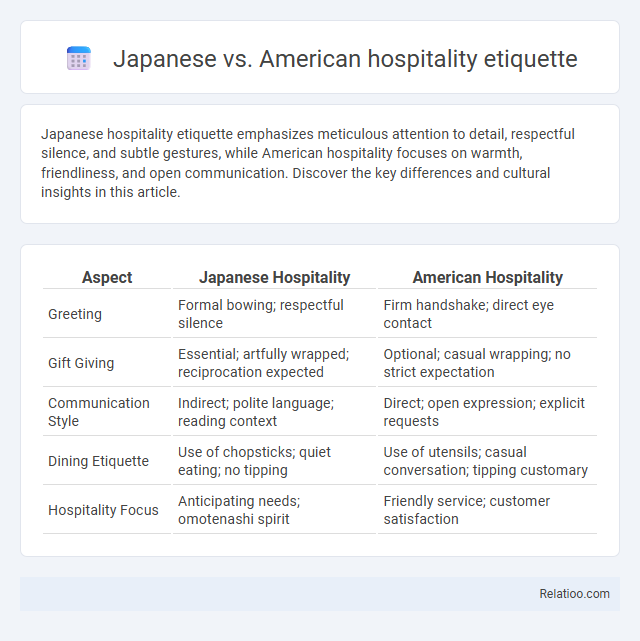Japanese hospitality etiquette emphasizes meticulous attention to detail, respectful silence, and subtle gestures, while American hospitality focuses on warmth, friendliness, and open communication. Discover the key differences and cultural insights in this article.
Table of Comparison
| Aspect | Japanese Hospitality | American Hospitality |
|---|---|---|
| Greeting | Formal bowing; respectful silence | Firm handshake; direct eye contact |
| Gift Giving | Essential; artfully wrapped; reciprocation expected | Optional; casual wrapping; no strict expectation |
| Communication Style | Indirect; polite language; reading context | Direct; open expression; explicit requests |
| Dining Etiquette | Use of chopsticks; quiet eating; no tipping | Use of utensils; casual conversation; tipping customary |
| Hospitality Focus | Anticipating needs; omotenashi spirit | Friendly service; customer satisfaction |
Introduction to Japanese and American Hospitality
Japanese hospitality, rooted in the concept of omotenashi, emphasizes meticulous attention to detail, respect, and anticipating guests' needs without expecting anything in return. American hospitality prioritizes warmth, friendliness, and creating a comfortable, casual atmosphere where guests feel welcome and valued. Both traditions highlight respect and care but differ in formality and cultural expressions of hospitality.
Core Values Shaping Hospitality in Japan and the US
Japanese hospitality etiquette centers on omotenashi, emphasizing wholehearted care, respect, and anticipating guests' needs with humility and meticulous attention to detail. In the US, hospitality etiquette prioritizes friendliness, individualism, and convenience, focusing on making Your experience comfortable and efficient through open communication and personalized service. Both cultures share core values of respect and guest satisfaction, but Japan's approach is deeply rooted in tradition and subtlety, while American hospitality embraces warmth and directness.
Greeting Customs: Bowing vs. Handshakes
In Japanese hospitality etiquette, bowing is the primary greeting custom, symbolizing respect and humility, with the depth and duration of the bow reflecting the level of formality or gratitude. American hospitality emphasizes handshakes as a standard greeting, conveying friendliness, confidence, and professionalism, often accompanied by direct eye contact and a firm grip. Understanding these distinctions in greeting customs helps you navigate cross-cultural interactions with greater awareness and respect.
Guest Treatment: Omotenashi vs. Friendliness
Japanese hospitality, or omotenashi, centers on meticulous attention to detail and anticipating guests' needs with quiet respect, ensuring a seamless, comfortable experience. American hospitality emphasizes warm friendliness and open, casual interactions that make guests feel welcomed and valued through direct communication. Understanding these cultural nuances enhances your ability to navigate guest treatment with sensitivity and authenticity in both contexts.
Communication Styles: Politeness and Directness
Japanese hospitality etiquette emphasizes indirect communication and high levels of politeness, using honorific language and non-verbal cues to convey respect and avoid confrontation. American hospitality etiquette values directness and clear verbal expression, with a focus on friendliness and openness while maintaining professional courtesy. Understanding these communication styles aids in delivering culturally appropriate and effective hospitality experiences.
Gift-Giving Traditions and Expectations
Japanese hospitality etiquette emphasizes the importance of gift-giving as a gesture of respect and appreciation, with presents often elaborately wrapped and exchanged at the beginning or end of visits. In contrast, American hospitality tends to favor more casual and varied gifts, prioritizing thoughtfulness over formality, with less emphasis on ritualized presentation. Both cultures value reciprocity and genuine gratitude, but Japanese traditions maintain strict protocols around timing, packaging, and the symbolism of gifts, whereas American practices focus on personal connection and practicality.
Dining Etiquette Differences
Japanese dining etiquette emphasizes respect and mindfulness, including rituals like removing shoes, using chopsticks properly, and expressing gratitude before and after meals; silence during dining is also common to appreciate the food's taste. American hospitality dining etiquette prioritizes casual conversation, prompt eating, and flexibility with seating arrangements, often accompanied by diverse table manners such as using forks and knives and informal toasts. Understanding these cultural differences enhances your experience by ensuring respectful interaction and smooth communication in international dining settings.
Personal Space and Body Language
Japanese hospitality etiquette emphasizes maintaining respectful personal space, avoiding direct eye contact, and using subtle body language such as bowing to convey humility and attentiveness, reflecting deep cultural norms of harmony. American hospitality etiquette generally allows for closer personal proximity, direct eye contact, and more expressive gestures like firm handshakes and smiles, signaling openness and friendliness. Understanding these differences in personal space and body language can enhance Your interactions and help avoid misunderstandings in cross-cultural settings.
Service Standards in Hotels and Restaurants
Japanese hospitality etiquette emphasizes meticulous attention to detail, respectful communication, and anticipatory service, ensuring guests feel honored and valued throughout their stay. American hospitality etiquette prioritizes friendly, personalized interaction, efficient service, and customer satisfaction, often encouraging open dialogue to address needs promptly. Your experience in hotels and restaurants will benefit from understanding these contrasting service standards, blending Japanese formality with American warmth to enhance overall guest engagement.
Cultural Sensitivity and Misunderstandings
Japanese hospitality etiquette emphasizes respect, humility, and indirect communication to avoid causing embarrassment, reflecting a deep cultural sensitivity rooted in harmony and consideration. American hospitality typically values directness, friendliness, and personal space, which may sometimes be perceived as overly casual or intrusive by Japanese hosts. Misunderstandings often arise when guests or hosts misinterpret these differing social cues, underscoring the importance of cultural awareness to navigate expectations and prevent unintentional offense in cross-cultural interactions.

Infographic: Japanese vs American hospitality etiquette
 relatioo.com
relatioo.com